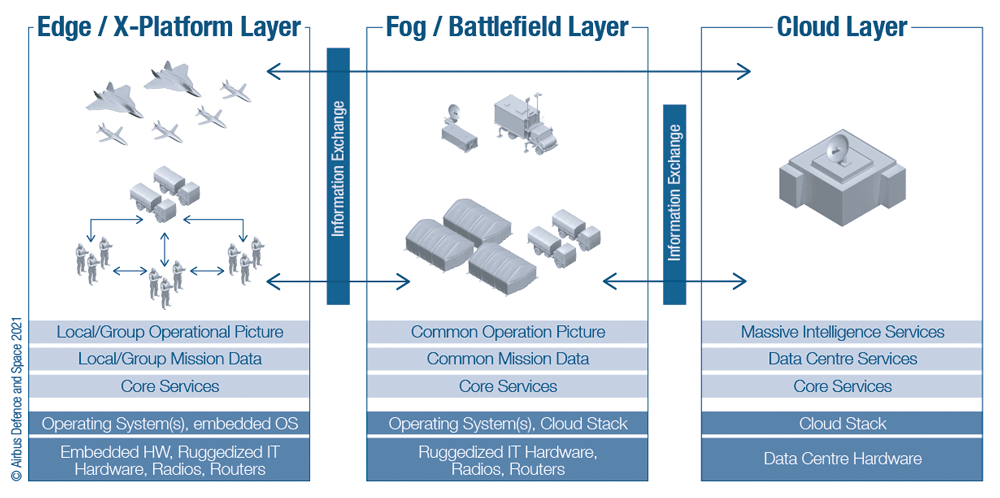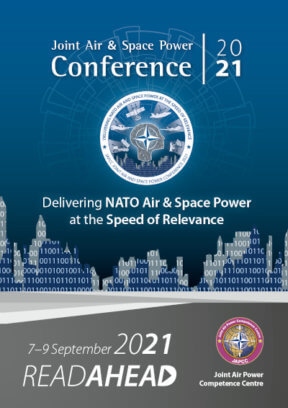Introduction
‘… lack of information sharing impedes operational effectiveness. Information sharing restrictions and national caveats limit interoperability solutions and reduce operational effectiveness across the domains.’1
This is one key finding of the Joint Air Power Strategy – Interoperability Study from January 2020. To overcome this shortfall, it requires a far higher level of automation and integration throughout the mission cycle.
The operational environment continues to change at high speed. Future military operations call for collaborative, more efficient, digitized, secure and cyber-resilient battlespace across Land, Air, Maritime, and Space domains.
Intelligence-driven operations and effects-based planning have been two principles proven valid for decades. Every operation starts with the assessment of an evolving crisis. This is the phase where we observe and orient. During this initial process, we are already gathering tremendous amounts of data, analysing, assessing and transforming them into information to be disseminated among the key actors, striving for information superiority. Considering the fact that seconds or even milliseconds will make the decisive difference between survival and destruction in a contested military environment, Multi-Domain Superiority will only be achieved through complete situational awareness based on data and advanced analytics to assist fast and more accurate decision-making. Therefore, future warfighting will require a far higher degree of processing, automation and integration throughout the mission cycle. To tackle these challenges, this paper argues on behalf of a Multi-Domain Combat Cloud (MDCC) solution to enable forces to ‘Be Informed as One and Act as One’.
What Is a Multi-Domain Combat Cloud, and What Will the Operational Benefit Be?
A ‘Combat Cloud’ is a connectivity of nodes, a dot-based elaboration of a cloud environment. This paper is proposing far more than what is typically seen as a network-attached cloud environment for the storage and processing of valuable data. What is required is a concept which strives for connecting manned and unmanned platforms, human-operated and human-controlled, but Artificial Intelligence (AI) supported systems.
NATO forces need to accelerate the operational tempo when completing Observe Orient Decide Act (OODA) loops better and faster than the opponent to take control of the situation. To overcome an opponent whose forces constitute a complex adaptive system, agility is key.
The objective is to get inside an opponent’s OODA loop, forcing a response to a situation that is no longer relevant.
A MDCC will speed up the OODA loop by providing common situational awareness through the instantaneous capturing, sharing, merging and processing of massive amounts of data from all connected manned and unmanned assets, by supplying predictive intelligence and assisted decision making, by allowing mission planning and re-planning: The enabler for distributed decision making and collaborative combat.
The envisioned approach is about merging data from various sources in a trusted way and turning that data into actionable information thanks to the latest analytical and learning technologies. Being able to share right information, at the right time in the right place will provide information superiority.

Informed as One – Seamless Exchange of Validated Information as Key Element in the MDCC
The MDCC shall be the enabler for joint all-domain operations at each command level, i.e. strategic, operational, and tactical. The same technical services and algorithms will be running on cloud servers in headquarters, in containers in forward operating bases, as well as on fighter aircraft, tanks, or ships. The aim is to achieve a seamless exchange of validated information at different layers leading to information superiority.
The Cloud Layer contains all systems which deal with large amounts of data. In general, these systems are only a few and the location of the systems is not relevant in the context of the operation.
For future MDCC add-ons we can expect a data-driven collaboration across assets and domains, including for example:
- high-level automation of data exchanges;
- predictive analytics and scenario calculation;
- wide area connectivity management;
- faster Planning Cycle;
- increased post-mission awareness.
The Fog Layer deals with a lesser amount of data linking the Cloud and Edge. It is envisaged to be a deployable or even mobile data node with high computing capability but compared to the cloud layer with limited data storage capacity. In general, these systems are only a few to many and the location of the systems is relevant in the context of the operation. In current operations these could be an AWACS or a smart MRTT.
For future MDCC add-ons we can expect smarter information sharing and decentralized autonomous combat Command and Control (C2), including:
- higher flexibility and dynamic reactivity on real-time changes;
- increased Situational Awareness by distributed collaborative sensors;
- reallocate dynamically C2 roles between assets and nodes.
The Edge Layer contains systems which predominantly contain effectors and/or sensors. In general, these systems provide the data and lower-level information which are consumed by systems in the Fog- and Cloud Layer in order to generate higher-level information or intelligence.
For future MDCC add-ons we can expect a higher level of collaboration of manned and unmanned assets, including for example:
- C2 of unmanned assets;
- high-level automation of flight management;
- continuous shared information;
- continuous re-planning;
- common operational picture.
The Core – Multi-Domain Combat Cloud Architecture
Throughout the complete mission, cycle data are collected from various sensors across all domains, which need to be transferred into actionable information provided to all actors and nodes through a common or shared information space. All actors need to work with and on a Common Relevant Operational Picture regardless of their task. This is a prerequisite for synchronized collaboration beyond the boundaries of component commands and domains.
A MDCC will need a modular, scalable and flexible architecture to meet current and future unknown threats. Using standardized interfaces, the communications services will interconnect the sensor, effector and C2 nodes belonging to the various assets to allow real-time and/or near-real-time resilient secured linking. Such communication services will consist of communication networks, transmission systems, relay stations, tributary stations, and terminal equipment capable to form an integrated whole.
Turning the connected assets into actionable sensing, effecting, and C2 nodes will require interoperable information systems defined as ‘Core Services’. This allows disaggregating of operational functions into applications and services and aggregating massive sets of data on a common cloud platform. Such information systems are integrated sets of components for collecting, storing, processing, and distributing data to deliver validated information.
Ensuring that all actionable nodes can collaborate across the C2 process will require the background capabilities defined as technical services in support of all mission types and operational capabilities. Such technical services will be hosted on multiple physical platforms across Air, Land, Sea, and Space to ensure resilience. Within a given platform, each actionable node will be a requester and a provider for technical services. Load balancing between receiving and providing data and information will be dynamically managed to ensure optimum performance considering the given constraints.
The technical services requirements will be derived from the operational needs expressed by the collection of User Facing Capabilities. Technical services will, according to the Consultation, Command and Control (C3) NATO Taxonomy,2 include the Community of Interest Specific Services and Enabling ones.
Act as One – the Application and Information Layer
Human-Machine Collaboration will be key to Human Facing Appli cations so that humans can focus on supervising and deciding in constrained environments rather than processing and tasking. Such meaningful human control is commonly referred to as human in or on the loop.
Within the overall system of systems of actionable nodes, multiple effect paths will be running concurrently. In light of such complexity, AI will be required to orchestrate the different actionable nodes and to manage massive data which will empower the C2 process.
Delivering information and digital products to a network of connected platforms also provides opportunities for cyber-attacks. End-to-end robust cybersecurity will allow protection and timely response to attacks or threats to prevent the tampering of infrastructure and/or the ‘injection’ of fake data and/or malware.
Service structuring of MDCC architecture enables an efficient, effective, and relevant supply of validated information with the same information but automatically optimized for each user. Supported by the application, the user decides on the purpose of the information provided in a cognitive manner. Orchestrating the different actionable nodes and managing the massive amount of data generated during the mission cycle requires AI and Machine Learning (ML). With advanced analytics and AI the Observe and Orient phases of the OODA Loop will benefit through quality and time thus reducing the workload of the human beings allowing them to focus on the Decide and Act phase. AI and Human-Machine Collaboration will contribute to information and decision superiority ensuring meaningful control throughout the mission cycle.
Conclusions
Thanks to long-lasting experience and projects in the defence area, a MDCC is/will be compliant with current and evolving C3 NATO Taxonomy and thus provides an essential basis for synchronization and interoperability.
The main advantage of such MDCC architecture is the modularity and scalability for the development of applications. It allows creating new services, orchestrating them differently and deploying them in a flexible way. Agility and flexibility within the delegation of C2 for example, within the context of Alliance Future Surveillance and Command System rests on service structuring.
The usage of open standards and well-defined service ‘Application Programming Interfaces’ allows building interoperable applications for a multi-vendor environment such as the Multi-Domain battlespace. Depending on the technical state of play, different national operational applications can be safely integrated into such Combat Cloud architecture. This allows for synchronization as a prerequisite to act as one.











